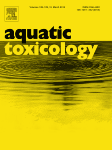The initial tolerance to sub-lethal Cd exposure is the same among ten naïve pond populations of Daphnia magna, but their micro-evolutionary potential to develop resistance is very different
The initial tolerance to sub-lethal Cd exposure is the same among ten naïve pond populations of Daphnia magna, but their micro-evolutionary potential to develop resistance is very different
 Differences between the ecological reality in the field and the controlled test conditions in the lab make ecotoxicological results sometimes difficult to extrapolate from the lab to the situation in the field. One of the conditions that are different in the field compared to the lab is the presence of different individuals of an organism. First, each of these individuals differ in their tolerance to toxic stress. Second, the presence of different individuals allow for evolution which results in a group of individuals having a higher tolerance to toxic stress compared to an unevolved group. To characterize these two problems and to investigate possible solutions to them, we compared in our latest paper the tolerance and the potential to evolve in ten groups of individuals orginating from ten natural 'field' populations in Belgium. Although the tolerance of the individuals in these ten groups is quite similar, their potential to evolve an enhanced tolerance is very different.
Differences between the ecological reality in the field and the controlled test conditions in the lab make ecotoxicological results sometimes difficult to extrapolate from the lab to the situation in the field. One of the conditions that are different in the field compared to the lab is the presence of different individuals of an organism. First, each of these individuals differ in their tolerance to toxic stress. Second, the presence of different individuals allow for evolution which results in a group of individuals having a higher tolerance to toxic stress compared to an unevolved group. To characterize these two problems and to investigate possible solutions to them, we compared in our latest paper the tolerance and the potential to evolve in ten groups of individuals orginating from ten natural 'field' populations in Belgium. Although the tolerance of the individuals in these ten groups is quite similar, their potential to evolve an enhanced tolerance is very different.
Scientific abstract
Genetic variation complicates predictions of both the initial tolerance and the long-term (micro-evolutionary) response of natural Daphnia populations to chemical stressors from results of standard single-clone laboratory ecotoxicity tests. In order to investigate possible solutions to this problem, we aimed to compare the initial sub-lethal tolerance to Cd of 10 naïve natural pond populations of Daphnia magna as well as their evolutionary potential to develop increased resistance. We did so by measuring reproductive performance of 120 clones, i.e. 12 clones hatched from the recent dormant egg bank of each of 10 populations, both in absence (Cd-free control) and presence of 4.4 μg Cd/L. We show that the initial tolerance, defined as the reproductive performance of individuals of the first generation exposed to Cd relative to that in a Cd-free control was not significantly different among the 10 studied pond populations and averaged 0.82 ± 0.04 over these populations. Moreover, these populations' initial tolerances were also not significantly different from the mean initial tolerance of 0.87 ± 0.08 at 4.0 μg Cd/L measured for a group of 7 often-used laboratory clones, collected from a range of European ecotoxicity testing laboratories. This indicates that the initial response of naïve natural pond populations to sub-lethal Cd can be relatively accurately predicted from ecotoxicity test data from only a handful of laboratory clones. We then used estimates of broad-sense heritability of Cd tolerance (H2) – based on the same dataset – as a proxy of these populations' capacities to evolutionarily respond to Cd in terms of the development of increased resistance, which is here defined as the increase with time of the frequency of clones with a higher Cd tolerance in the population (accompanied with an increase of mean Cd-tolerance of the population above the initial tolerance). We show that the populations' estimated H2 values of Cd-tolerance cover almost the entire theoretically possible range, ranging from not significantly different from zero (for five populations) to between 0.48 and 0.81 (for the five other populations). This indicates that, unlike the initial tolerance to Cd, the (long-term) micro-evolutionary response to Cd may be very different among natural pond populations. Therefore, we conclude that it may be very difficult to predict the long-term response of an unstudied population to chemical stress from tolerance data on a sample of other populations. It is therefore suggested that new methods for forecasting long-term responses should be explored, such as the development of predictive models based on the combination of population-genomic and tolerance time-series data.
Post-print full text [PDF]
Full reference
Messiaen M, Janssen C, De Meester L, De Schamphelaere KAC. 2013. The initial tolerance to sub-lethal Cd exposure is the same among ten naïve pond populations of Daphnia magna, but their micro-evolutionary potential to develop resistance is very different. Aquatic Toxicology, 144-145:322-331. doi:10.1016/j.aquatox.2013.10.016
